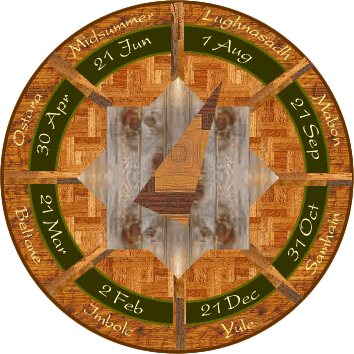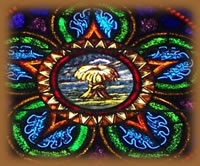The Pagan ritual cycle is often called the wheel of the year. Four of the festivals have Celtic origins and are known by their Celtic names (Samhain, Imbolc, Beltain and Lughnasadh).The others coincide with the solar equinoxes and solstices, and as such, they are often celebrated on the opposite date in the southern hemisphere.
The festival of Samhain (also known as Hallowe’en) marks the beginning of the Pagan year; Lughnasadh coincides with the grain harvest.

And
he took bread, gave thanks and broke it, and gave it to them, saying,
“This is my body given for you; do this in remembrance of me.”
(Luke 22:19)
The Christian mass remembers another god whose self-sacrifice ensures the survival—on both a body and soul level—of his people.

Detail
of church window
Michigan,
USA
They
took a plough and plough'd him down,
Put clods upon his head,
And they hae sworn a solemn oath
John Barleycorn was dead.
Robert Burns
In some Wiccan traditions, Lughnasadh honours the death of the grain god, whose self-sacrifice ensures an on-going fertility; the spirit of the dying John Barleycorn enters the fields, where it is resurrected in the tender green sprouts of the next season’s crop.
Although Lughnasadh is named for the Celtic god Lugh, the festival originates not from the sun-god’s death, but rather from the funeral games that the god hosted to commemorate the death of his foster mother, Taillte.
Taillte was a princess of the Fir Bolg, the fourth of the mythical invaders of Ireland. After the defeat of her people by the Tuatha De Dannan, she was obliged by them to clear a vast forest for the purpose of planting grain, and it is said that she died of exhaustion completing this task. It is possible that this myth reflects the transition from one way of living and set of beliefs to another, just as—when he spoke to his disciples on the occasion of the Last Supper—Jesus drew from the Jewish traditions of Passover.